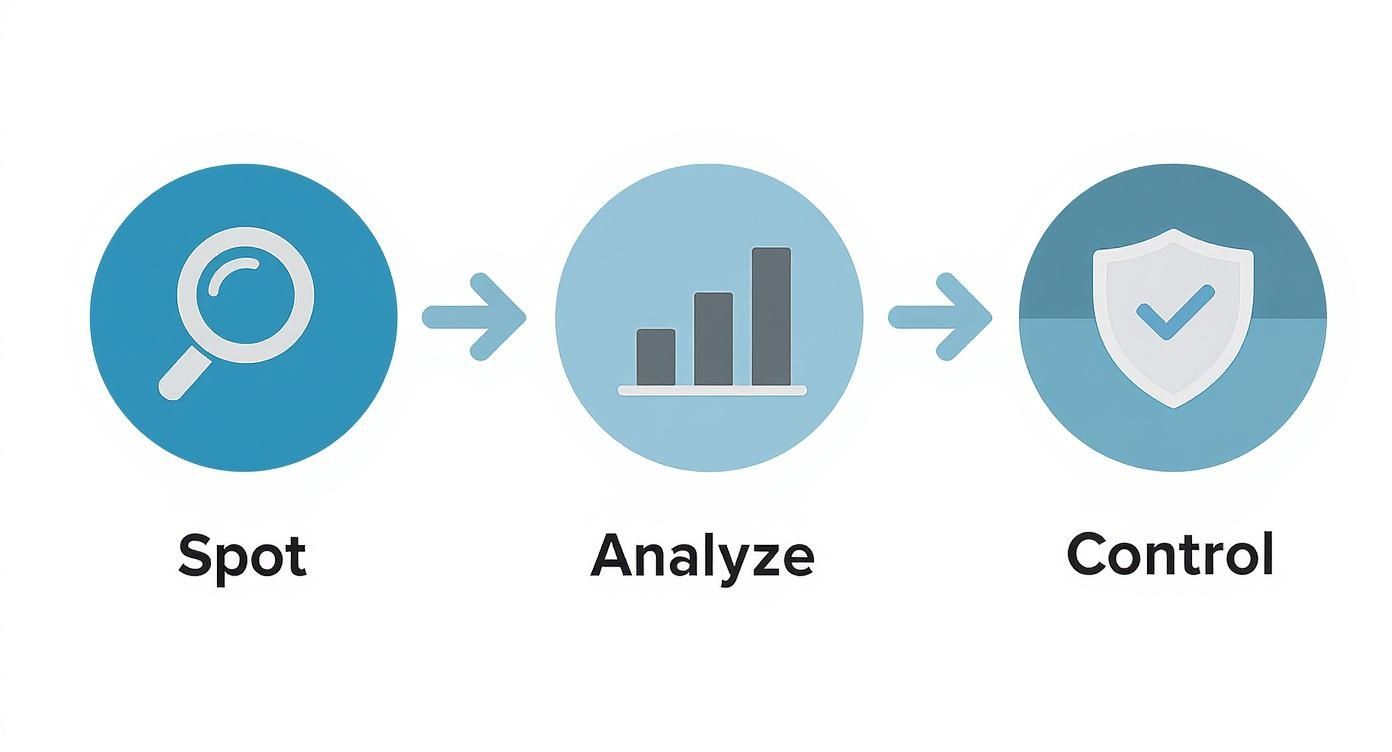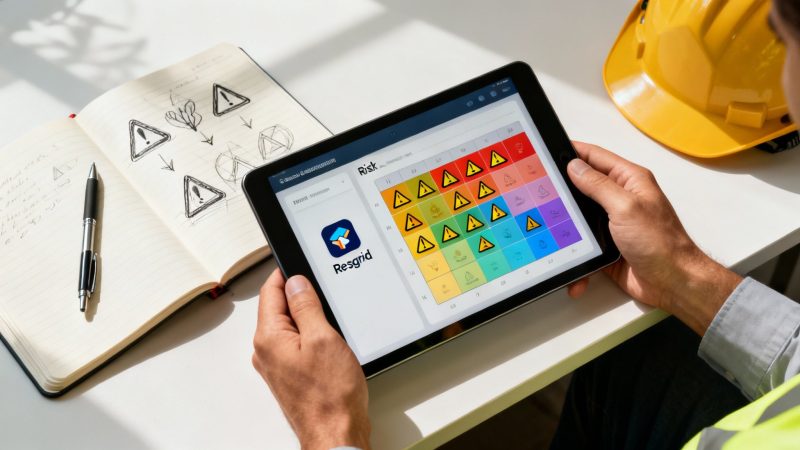how to conduct risk assessment: quick, practical steps
At its core, a risk assessment is pretty straightforward. You're really just doing three things: spotting potential hazards, figuring out how likely they are to happen and what the damage would be, and then putting smart controls in place to deal with them. This isn't just a compliance task; it's a powerful strategy that actively protects your assets, saves money, and keeps the lights on.
Why Modern Risk Assessment Is a Business Superpower
Forget about dusty old checklists and box-ticking exercises. A modern risk assessment is a dynamic, strategic tool that builds real resilience and sharpens your decision-making. In a world where disruption is the new normal—from supply chain shocks to constant cyber threats—you just can't afford to be reactive anymore. The businesses that really thrive are the ones that can see what's coming and prepare for it.
This means shifting away from a static, compliance-focused mindset and toward dynamic, scenario-based thinking. Instead of just asking, "Are we compliant?" leaders are now asking, "What could actually go wrong, and are we ready if it does?" That proactive approach is what separates the prepared from the paralyzed.
The Core Process Made Simple
When you strip it all down, the process is simple. It's about identifying dangers, analyzing the fallout, and putting practical safeguards in place. The infographic below breaks down this powerful three-step flow.

This visual shows the logical journey from discovery (Spot) to evaluation (Analyze) and finally to action (Control). It’s not a one-and-done deal, either. This should be a continuous loop of improvement. The real magic here is turning abstract threats into a prioritized, manageable to-do list.
To give you a clearer picture of the end-to-end process, here's a breakdown of the five key phases involved.
The 5 Core Phases of a Risk Assessment
| Phase | Objective | Key Outcome |
|---|---|---|
| 1. Planning & Scoping | Define the boundaries, goals, and resources for the assessment. | A clear plan of action and scope document. |
| 2. Hazard Identification | Systematically identify all potential hazards within the defined scope. | A comprehensive list of potential threats. |
| 3. Risk Analysis | Determine the likelihood and potential impact of each identified hazard. | A prioritized list of risks based on severity. |
| 4. Risk Evaluation | Compare the analyzed risks against predefined tolerance levels. | A decision on which risks require immediate action. |
| 5. Mitigation & Control | Develop and implement strategies to reduce or eliminate unacceptable risks. | Actionable control measures and a mitigation plan. |
Each of these phases builds on the last, creating a structured path from uncertainty to confident, proactive management.
Beyond Compliance to Financial Strategy
How we perceive risk is always in flux. The Global Risks Report 2025, which gathered insights from over 900 leaders, revealed a huge shift in what's considered a top threat. For instance, state-based armed conflict, once a lower-priority concern, is now seen as the number one immediate risk by 23% of those surveyed. This just drives home the need to look at risks across different timelines—what's a threat today versus what could be a problem in five years.
A thorough risk assessment is the single most effective way to reduce long-term costs. It ensures that your security resources—money, time, and personnel—are strategically aligned with your most critical business assets and regulatory requirements.
Here's a practical example: A manufacturing company identifies a critical piece of machinery as a hazard. The analysis shows that if it breaks down, it would halt production and cost the company $50,000 per day. The control? A preventive maintenance plan that costs just $2,000 annually. Suddenly, that control becomes an obvious and highly profitable investment. The actionable insight here is that the assessment directly justifies the maintenance budget, turning a perceived cost into a guaranteed ROI by preventing a far larger loss.
This is how a risk assessment stops being a chore and starts contributing directly to your bottom line. It's also a fundamental part of protecting your operations, which is why having strong security measures is so critical.
Uncovering Hazards Before They Become Disasters
The core of any solid risk assessment is a relentless, almost obsessive hunt for what could go wrong. This isn’t about vague worries; it’s a systematic process to pinpoint specific hazards before they turn into expensive disasters. The goal here is to build a complete inventory of potential dangers by looking at every facet of your operation—your people, equipment, materials, and the environment they all share.

A classic mistake is making this a solo mission for a manager sitting in an office. I can tell you from experience, the best insights almost always come from the people on the front lines. They know the workarounds, the "unofficial" procedures, and the quirks of the machinery that you'll never find in a manual. Tapping into that collective knowledge is absolutely non-negotiable for an accurate assessment.
Tapping Into Frontline Knowledge
Your team is your single most valuable hazard detection tool. But getting their input means more than just sending a quick email. You have to create structured opportunities for them to share what they really know.
Start with focused brainstorming sessions. Don't just ask, "What are the risks?" That’s too broad. Instead, frame the discussion around specific scenarios. For instance, ask a warehouse team, "What are the three most likely ways someone could get hurt in the loading bay?" This pushes them to give you concrete, experience-based answers.
Next, try some informal employee interviews. Sit down with individuals or small groups away from their immediate supervisors. This creates a safe space where they feel comfortable sharing concerns they might otherwise keep quiet about, like feeling pressured to skip safety checks to hit a deadline.
A well-documented hazard identification process does more than just improve safety—it directly impacts your bottom line. Insurance carriers often provide lower premiums to businesses that can demonstrate proactive risk management, turning your diligence into tangible cost savings.
The Power of a Systematic Walk-Through
While talking to your team is critical, nothing replaces seeing the work environment with your own eyes. A systematic walk-through, or workplace inspection, is where you actively hunt for hazards. But just wandering around aimlessly won't cut it. You need a structured approach.
Use a checklist to make sure you cover all the bases. A good checklist helps you look at different categories of hazards so nothing gets overlooked.
- Physical Hazards: Be on the lookout for slip-and-fall dangers like wet floors or cluttered walkways. Check for unguarded machinery and electrical risks from things like frayed wiring.
- Ergonomic Hazards: Watch how people work. Are workstations set up correctly to prevent repetitive strain? Are employees lifting heavy objects without the right technique or equipment?
- Chemical Hazards: Check for improper storage of chemicals, missing Safety Data Sheets (SDS), or poor ventilation in areas where fumes are present.
- Psychosocial Hazards: These are less visible but just as dangerous. Think about factors like excessive workload, workplace bullying, or a lack of role clarity that can lead to stress and burnout.
Using a Job Hazard Analysis
For tasks that are particularly high-risk, a Job Hazard Analysis (JHA) is an incredibly effective tool. A JHA breaks down a specific job into its individual steps and then identifies the potential hazards tied to each one.
For example, a JHA for a machine operator might look something like this:
| Task Step | Potential Hazard | Recommended Control |
|---|---|---|
| 1. Loading Material | Caught-in/crush injury from moving parts. | Install a two-hand control system. |
| 2. Operating Machine | Hearing damage from high noise levels. | Require hearing protection (PPE). |
| 3. Clearing a Jam | Lacerations from sharp components. | Implement a lock-out/tag-out procedure. |
This kind of detailed breakdown moves you from a general awareness of danger to a specific, actionable plan for control. Modern workplaces are also seeing the benefits of technology in this area. For example, implementing robust augmented reality safety programs can give workers critical real-time information and guidance, helping to prevent incidents before they even happen. By combining these hands-on methods, you create a truly comprehensive picture of the hazards your organization is facing.
Alright, you've got your list of potential hazards. Now what? Staring at a long list can feel a bit paralyzing. The trick is to turn that chaos into a clear, prioritized action plan. This is where we shift from just spotting problems to making smart decisions about where to put your time and resources.

This whole process boils down to two simple but powerful ideas: likelihood (how likely is it that this thing will actually happen?) and severity (if it does happen, how bad will the fallout be?). By looking at every hazard through this lens, you can start to objectively sort your risks from "drop everything and fix this now" to "we'll keep an eye on it."
Getting a Handle on Likelihood and Severity
Thinking this way keeps you from blowing your budget on a rare, flashy threat while ignoring the small, nagging issues that bleed you dry day after day. You're looking for the sweet spot where your efforts will make the biggest difference.
Let's take a practical example: a critical server failure at a small e-commerce business. The severity is off the charts—it could stop all sales, tank customer trust, and cost thousands every hour. But, if that business has solid cloud backups that kick in automatically, the likelihood of a catastrophic, business-ending data loss is actually very low.
On the flip side, think about minor glitches in an internal app. The severity of any single glitch is low, maybe causing a five-minute headache for one person. But if those glitches are popping up multiple times a day for your whole team, their high likelihood adds up to a massive drain on productivity.
Using a Risk Matrix to See Your Priorities Clearly
A risk matrix is a straightforward visual tool that helps you map out each risk based on its likelihood and severity. It's a game-changer for cutting through the noise. You just create a simple grid, often color-coded, to plot everything out.
Here’s a practical way to set up a 3×3 matrix for your analysis:
| Likelihood | Low Severity | Medium Severity | High Severity |
|---|---|---|---|
| High | Medium Priority | High Priority | Critical Priority |
| Medium | Low Priority | Medium Priority | High Priority |
| Low | Low Priority | Low Priority | Medium Priority |
Once you start plotting your hazards on this grid, you get an instant visual of what needs your focus. Anything that lands in that "Critical Priority" zone is what you need to tackle immediately.
The real magic of a risk matrix is that it forces you to be objective. It stops decisions from being driven by gut feelings or whoever yells the loudest and grounds them in a consistent, repeatable framework. This is how you build a real business case for spending on safety and continuity.
This kind of quantitative thinking is becoming the standard. The World Risk Report 2025, for example, assesses disaster risk for 193 countries by calculating their exposure and ability to cope with events like floods and earthquakes. It’s a perfect example of how solid data can turn risk assessment from a guessing game into a precise science, helping people prioritize where to send help. You can dig into more of these global assessment methods from the Harvard Global Health Institute.
Making It Actionable Without Breaking the Bank
With your risks properly sorted, you can start making some strategic calls. This analysis feeds directly into your budget, showing you where an investment will actually pay off. No more wasting money on expensive fixes for things that are unlikely to happen and wouldn't be a big deal anyway.
Let's look at a couple of practical scenarios:
-
Scenario A (High Severity, Low Likelihood): A fire in the server room.
- Analysis: The impact would be catastrophic, but it's pretty unlikely.
- Actionable Insight: Instead of dropping $50,000 on a massive fire suppression system, maybe a more cost-effective move is to migrate critical services to a cloud provider for $5,000 a year. You've essentially transferred the risk and saved $45,000 upfront.
-
Scenario B (Low Severity, High Likelihood): Repetitive strain injuries from bad desk setups.
- Analysis: The impact on any one person is minor, but it happens all the time, leading to sick days and potential claims.
- Actionable Insight: A $2,000 investment in ergonomic training and better chairs could easily save you thousands in lost productivity and healthcare costs over the year. The assessment proves this isn't just a "nice-to-have" but a smart financial decision.
This analytical step is what makes risk management a core part of your financial strategy, not just a box to check. It's especially crucial when you're managing data and working with different tech partners. Understanding your own risks helps you better vet the security of external services you depend on, like the https://resgrid.com/subprocessors we use to deliver our platform. When you analyze and prioritize correctly, you build a stronger, more efficient organization from the inside out.
Putting Smart, Cost-Effective Controls into Action
Once you've sized up your risks and prioritized them, it's time to get your hands dirty. This is the part where you stop analyzing and start doing—choosing and implementing controls that actually knock down those threats. The real trick isn't just finding any solution, but finding the smartest one that's both effective and doesn't break the bank.
A battle-tested way to think about this is the Hierarchy of Controls. Picture it as a pyramid. The most permanent and effective solutions are at the top, while the temporary, less effective ones are at the bottom. Sticking to the top tiers almost always saves you the most money in the long run.
Prioritizing Controls for the Biggest Bang for Your Buck
This hierarchy gives you a clear playbook for tackling risks, pushing you to think bigger before you settle for a quick fix. The levels are Elimination, Substitution, Engineering, Administrative, and finally, Personal Protective Equipment (PPE).
Let’s walk through each one with some practical, money-saving examples.
Elimination and Substitution: The Gold Standard
Right at the top of the pyramid, you have Elimination (getting rid of the hazard completely) and Substitution (swapping the hazard for something safer). These are your heavy hitters because they deal with the root cause of the risk once and for all.
-
Practical Elimination: A small factory has a ridiculously loud and high-maintenance machine for a minor process. Instead of shelling out for hearing protection (PPE) and complex maintenance schedules (Admin controls), they do the math. They realize they can outsource that specific task to a specialty shop for less than what they spend on annual upkeep. Boom. They eliminate the machine, the noise, the maintenance headaches, and all the costs that went with them.
-
Practical Substitution: An office cleaning crew relies on a pretty harsh chemical cleaner. The risks are real: skin irritation, breathing issues, and the need for specialized gear and training. By substituting it with a certified, non-toxic, plant-based cleaner, they erase the health hazard. This move saves them a ton on recurring PPE purchases, specialized training, and potential workers' comp claims down the line.
Engineering and Administrative Controls
When you just can't get rid of a hazard, your next best moves are Engineering Controls (physically separating people from the danger) and Administrative Controls (changing how people do their work).
Engineering controls are physical fixes to the environment. Think of them as a one-time investment that keeps on protecting people without you having to constantly remind them.
- Practical Engineering: A warehouse conveyor belt has exposed gears—a classic "caught-in" hazard. The first instinct might be to just tell everyone to be careful (an Administrative control). But a one-time investment of $800 to install a permanent safety guard is infinitely better. That single action prevents countless potential injuries, saving a fortune in lost work time and liability.
Administrative controls are all about procedures and policies. They're not as solid because they count on people to follow the rules perfectly every single time, which, let's be honest, is a big ask.
- Practical Administrative: A logistics company needs to manage driver fatigue. They implement a strict policy: drivers can't be on the road for more than eight hours without a mandatory 10-hour break. It's cheaper than buying new trucks with fancy fatigue-detection tech (an Engineering control), but it only works if it's constantly monitored and enforced.
Focusing on higher-level controls like elimination or engineering is a powerful financial strategy. It slashes recurring costs tied to training, supervision, and disposable equipment, turning a safety investment into a direct boost to your operational efficiency.
Personal Protective Equipment: Your Last Resort
At the very bottom of the pyramid is Personal Protective Equipment (PPE). We're talking gloves, hard hats, safety glasses, and respirators. While you absolutely need PPE in many situations, it should always be your last line of defense.
It's seen as the least effective control because it doesn't remove the hazard at all. It just puts a temporary barrier between a person and the danger. Its success hinges entirely on the gear being selected correctly, fitting right, being worn 100% of the time, and kept in good condition. The costs of buying, replacing, and managing all that PPE add up fast.
For teams trying to manage these complex moving parts, plugging risk controls into a larger operational platform can be a lifesaver. You can check out the features that support incident management and personnel coordination, which are crucial for making sure administrative controls are actually being followed. This integration turns policy into practice, saving money by preventing the human error that leads to costly incidents. By making a conscious effort to move up the hierarchy, you build a safer, more resilient, and ultimately more profitable organization.
Keeping Your Risk Assessment Relevant and Effective
A risk assessment isn't a trophy you put on a shelf and admire. It’s a living, breathing document that loses its value the moment it becomes outdated. To protect your people and operations over the long haul, you have to treat your assessment as a dynamic tool that needs regular care and attention.
Without this final step, all the hard work you put into identifying hazards and implementing controls can quickly become irrelevant. New equipment, changing procedures, or even shifts in personnel can introduce fresh risks that your original assessment never saw coming. This is why building a cycle of review is non-negotiable.

What to Document in Your Risk Assessment
Clear and thorough documentation is your single greatest asset after the assessment is complete. It’s not just about compliance; it's your proof of due diligence. When an auditor or inspector shows up, a well-kept record is your first and best line of defense.
Your records should be straightforward and easy for anyone to understand. At a minimum, every risk assessment document should include:
- Hazards Identified: A clear list of every potential hazard you discovered.
- Risk Analysis Details: Who might be harmed and how, plus your evaluation of the risk level (likelihood and severity).
- Control Measures: The specific actions you have taken or plan to take to mitigate each risk.
- Responsibility and Deadlines: Who owns the implementation of each control and the target date for completion.
- Review Date: The date the assessment was conducted and when the next review is scheduled.
Your documentation is a powerful financial shield. In the event of a regulatory audit or legal dispute, these records provide tangible proof of your commitment to safety and proactive management. This diligence can dramatically reduce fines and liability, turning simple paperwork into a significant cost-saving tool.
Establishing a Practical Review Schedule
So, how often should you dust off your assessment and give it a fresh look? The answer isn't a single date on the calendar. Instead, you need clear triggers that prompt an immediate review. Waiting for an annual meeting is often too late.
The financial stakes of ignoring this are enormous. The United Nations' Global Assessment Report (GAR) 2025 found that disaster-related economic losses now exceed $2.3 trillion every single year. The report directly links major economic shocks to inadequate risk assessment, framing it as a core economic strategy, not just a safety exercise. You can explore the full findings on how risk reduction protects economic resilience.
To stay ahead of the curve, your review schedule should be built around key operational events.
Think of these triggers as your early warning system. They tell you it's time to pull out the assessment and make sure it still holds up. Here’s a breakdown of the most common events that should kick off a review.
Risk Assessment Review Triggers
| Trigger Event | Reason for Review | Practical Example |
|---|---|---|
| After Any Incident | An accident, injury, or even a near-miss is a clear signal that existing controls failed or a hazard was overlooked. | A warehouse worker narrowly avoids a falling box, prompting a review of all storage and stacking procedures. |
| New Processes or Equipment | Introducing new machinery, software, or workflows brings new, unevaluated risks into your environment. | The company installs a new automated packaging machine, requiring a fresh assessment of its operational hazards. |
| Change in Personnel | New team members may lack experience, or a change in leadership could alter safety priorities and procedures. | A new team manager takes over a department, triggering a review to ensure they understand existing risks and controls. |
| Legislative Changes | New regulations or industry standards may impose new requirements that your current assessment doesn't cover. | A new government safety regulation is passed, requiring updated documentation and control measures for certain chemicals. |
| Annual Review | A scheduled annual review acts as a safety net to catch any subtle changes that might have been missed throughout the year. | On a set date each year, the safety committee meets to go through every active risk assessment line-by-line. |
By embedding these triggers into your operational culture, you ensure your risk management plan stays sharp and relevant. It's the only way to effectively protect both your people and your bottom line.
Common Questions About Risk Assessments
Even with a solid process mapped out, a few practical questions always pop up when teams start doing formal risk assessments. It's totally normal. Getting these fundamentals right from the start can make the whole effort a lot smoother and, frankly, a lot more effective.
Let's tackle some of the most common ones I hear.
How Often Should I Conduct a Risk Assessment?
The textbook answer is at least annually. But thinking of this as just a once-a-year checkbox item is a huge mistake. Your risk assessment needs to be a living document, not something that collects dust on a shelf.
You absolutely must trigger a new assessment or a major review any time something significant changes in your operations. What counts as "significant"?
- Bringing in new machinery or tech.
- Making a major change to a core work process.
- After any accident, injury, or even a near-miss. Seriously, don't ignore the close calls.
Treating your assessment like a dynamic tool isn't just about safety; it saves money. A few hours of team time to reassess risks when you roll out new software could prevent a data breach that costs you tens of thousands in downtime and fines. It’s a no-brainer.
What Is the Difference Between a Hazard and a Risk?
This one is critical. Getting this distinction wrong is probably the single biggest reason risk assessments fail or waste resources.
A hazard is anything with the potential to cause harm. It’s the source of the danger.
- A puddle of water on a tile floor is a hazard.
- An unguarded blade on a saw is a hazard.
- A server that hasn't been patched for months is a hazard.
A risk, on the other hand, is the likelihood of that hazard actually hurting someone, combined with the severity of that harm. The puddle of water (the hazard) presents a very high risk in the middle of a busy hospital corridor, but almost zero risk in a locked, rarely used storage closet.
The risk is what tells you how fast you need to act.
Can I Use a Template for My Risk Assessment?
Absolutely. In fact, you should. Starting with a good template is a smart way to give yourself structure and make sure you don't miss obvious steps. It's your guide, prompting you to consider different hazard categories and document everything consistently.
But—and this is a big but—a template is only a starting point. It's never the final product.
Never rely solely on a generic template. The most critical, non-obvious hazards are almost always discovered through direct observation and conversation with the frontline employees who face them daily. They know the workarounds and informal procedures that create unique risks.
Every single workplace is unique. The real value comes when you take that template and customize it by walking the floor, looking at your specific environment, and talking to your team.
Who Should Be Involved in a Risk Assessment?
A risk assessment should never be a solo mission conducted by one manager sitting in an office. It’s a team sport, and its accuracy hinges on getting a mix of perspectives.
Your assessment team should be a cross-functional group that includes:
- Managers and Supervisors: They get the official processes and business goals.
- Frontline Employees: They know the practical realities, the dangers, and the daily challenges of their jobs. Their input is gold.
- Safety Reps or Specialists: If you have them, their technical expertise is invaluable.
- Maintenance Staff: These folks have deep knowledge of equipment and infrastructure weak spots.
Involving employees from the get-go isn't just about getting better information. It’s a powerful way to get buy-in. When people are part of identifying a problem, they are far more likely to get on board with the solution. This collaboration dramatically increases the chance that new safety controls will actually stick.
Think about it: a manager might not see the ergonomic risk of a particular workstation setup. But the employee who uses it for eight hours a day will immediately tell you about the strain it causes. You can't capture that insight without them, and fixing it can save you thousands in long-term healthcare costs and lost productivity.
By integrating a robust risk assessment process into your operations, you build a more resilient and efficient organization. At Resgrid, LLC, we provide the tools to help first responders and businesses manage their personnel, resources, and communications, ensuring your team is always prepared to respond effectively when risks become reality. Learn more at https://resgrid.com.

